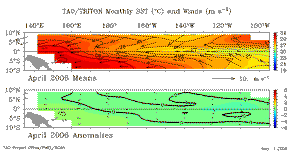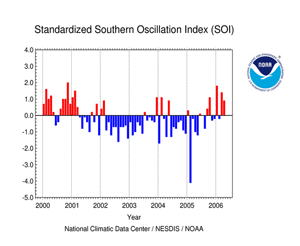LA NIÑA
CONDITIONS DISSIPATE IN THE EQUATORIAL PACIFIC
|
|
Sea-Surface
Temperatures (SSTs) and
Mixed-Layer Conditions: SSTs increased across most of the equatorial Pacific Ocean this past month. The observed SST anomalies during April increased close to average in the western and central parts of the tropical Pacific basin. In contrast, across the eastern Pacific the observed SST anomalies decreased further below-normal during April in the Niño 1+2 region. In the mixed-layer, water temperatures increased in the western and central Pacific, while cold anomalies remained near the South American coast with the largest monthly anomalies of -1°C located between 95°W and 110°W and at ~50-100 m depth. For the month, the SST anomaly in the Niño 3.4 Index region decreased to -0.11°C (-0.198°F). The SSTs in the western Pacific also warmed during April, with a monthly averaged Niño 4 Index of +0.06°C (+0.108°F) (map of Niño regions). For the most recent global ocean surface temperatures, please see the loop of satellite-derived weekly SST anomalies for April 2006. Below average SST anomalies persisted throughout the latter half of 2005 and into the first few months of 2006 in the central equatorial Pacific basin, and this can be seen in the data from NCDC's Extended Reconstructed Sea Surface Temperature dataset (ERSST version 2). Due to the recent warming of SSTs in the central tropical Pacific, the 3-month running mean of the Niño 3.4 index region increased above -0.5°C in April. (NOTE: A running 3-month mean SST anomaly below -0.5°C in the Niño 3.4 region is one indicator that a La Niña is occurring. For NOAA's official ENSO classification scheme, please see NOAA's El Niño/La Niña Index Definition and also see the CPC ENSO Diagnostic Discussion for NOAA's latest official assessment of ENSO conditions.) |
|
|
Equatorial Zonal Winds (U-Component
Winds) and Sea-Level Topography: The easterly trade winds were near-normal across the central and western equatorial Pacific basin during April, except for the far western equatorial Pacific where the easterly Trade winds were above average during the month. The most recent Pacific overpass of the NASA/JPL Jason-1 satellite observed a number of large positive sea level anomalies in the southwest and northwest equatorial Pacific, most likely associated with enhanced tropical convection in these areas. Negative anomalies that were measured in the central equatorial Pacific during early May were directly related to slightly colder-than-normal SST conditions (see the 6 May 2006 steric height anomaly and the 6 May 2006 surface height deviation maps). |
|
|
Outgoing
Longwave Radiation (OLR): The map to the left shows the spatial pattern of global OLR (in W m-2) observed by satellite during April. Positive OLR anomalies (typically associated with La Niña) have persisted over the past several months in the equatorial western Pacific region, centered near the Date Line, and tropical convection was again suppressed just north of the equator in the central and eastern Pacific this past month. The 3-month averaged OLR anomalies were also positive in the western Pacific basin near the Date Line. In contrast, enhanced tropical convection was observed farther west in Indonesia and the maritime continent region. The negative OLR anomalies over parts of Australia were associated with several tropical cyclones that impacted this region during the past month (for more information please go to the Tropical Cyclones section of the April Global Hazards page). The monthly-averaged OLR Index remained positive during April, but declined to near-neutral with a value of +0.5 W m-2 averaged across an area centered over the Date Line in the western Pacific between 160° E and 160° W (note that positive OLR Index values are typically associated with La Niña conditions in this region). April was the ninth consecutive month with a positive OLR Index, a period which coincided with the weak 2005-2006 La Niña event and the persistence of below average SSTs in the mixed-layer in the equatorial Pacific. Note that high frequency variability in OLR is typically associated with the Madden-Julian Oscillation (MJO, which is convective activity that propagates west to east in the near-equatorial region from the Indian Ocean into the Pacific Ocean approximately every 30-60 days). The latest MJO activity can be seen in CPC's graphs of Daily MJO Indices. |
| Southern Oscillation Index
(SOI): The standardized SOI remained positive in April, with an average value of +0.9 for the month. The SOI was inconsistent during the weak 2005-2006 La Niña, due to a number of fluctuations between a near-neutral value and both positive and negative indices. The observed positive values in March and April lagged the cold SSTs in the equatorial Pacific, although the slight decline in the index in April brought it closer to a neutral value. |
Additional Links
- ENSO Monitoring
- NOAA El Niño / La Niña Index Definition
- NOAA's Pacific Marine Environmental Laboratory (PMEL):
- NOAA's Climate Prediction Center (CPC):
- NOAA's Physical Science Laboratory
- NASA/JPL Ocean Surface Topography from Space
- Australian Bureau of Meteorology (BoM) Climate Driver Update
- IRI - International Research Institute
 NOAA's National Centers for Environmental Information
NOAA's National Centers for Environmental Information





 Larger image of
April OLR
Larger image of
April OLR Larger image
of Feb-Apr OLR
Larger image
of Feb-Apr OLR Larger image of April
OLR Index
Larger image of April
OLR Index